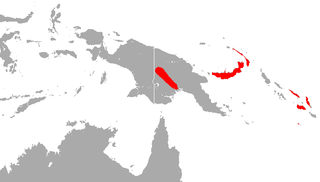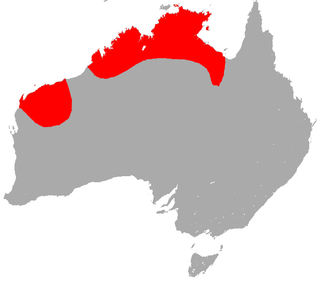
Emballonuridae is a family of microbats, many of which are referred to as sac-winged or sheath-tailed bats. They are widely distributed in tropical and subtropical regions around the world. The earliest fossil records are from the Eocene.

The northern broad-nosed bat is a species of the vespertilionid family of microbats. It can be found in northern Australia, Timor-Leste, and Papua New Guinea.
Finlayson's cave bat is a species of vesper bat found only in Australia.

Beccari's sheath-tailed bat is a species of sac-winged bat in the family Emballonuridae. It is found in New Guinea and in some nearby islands in both Indonesia and Papua New Guinea.

The large-eared sheath-tailed bat is a species of sac-winged bat in the family Emballonuridae. It is found in Papua New Guinea and the Solomon Islands.

Raffray's sheath-tailed bat is a species of sac-winged bat in the family Emballonuridae. It is found in eastern Indonesia, Papua New Guinea, and the Solomon Islands.

Seri's sheath-tailed bat is a species of sac-winged bat in the family Emballonuridae. It is found in the Bismarck Archipelago of Papua New Guinea and Yapen Island in Indonesia. Its roosts in caves.

The yellow-bellied sheath-tailed bat, also known as the yellow-bellied sheathtail or yellow-bellied pouched bat, is a microbat species of the family Emballonuridae found extensively in Australia and less commonly in parts of Papua New Guinea.

Saccolaimus is a genus of the family Emballonuridae, small insectivorous bats with distinctive sheathtails and pouches at the wrist.

The naked-rumped pouched bat, also known as the pouched tomb bat, is a species of sac-winged bat in the family Emballonuridae.

Taphozous is a genus of the family Emballonuridae. The wide distribution of the genus includes several regions of Australia, Indonesia, Papua New Guinea and Africa. Taphozous comes from the Greek τάφος, meaning "a tomb". The common names for species include variants on sac-winged, sheathtail, or tomb bats.

The coastal sheath-tailed bat, or coastal tomb bat, is a species of sheath-tailed bat in the family Emballonuridae. It is found in Australia and Papua New Guinea.

The common sheathtail bat, is a bat in the family Emballonuridae, occurring in northern Australia.

Hildegarde's tomb bat is a species of sac-winged bat in the family Emballonuridae. It is found near the coast in Kenya and Tanzania where it feeds in tropical dry forests and roosts in caves. It is a diurnal species and the International Union for Conservation of Nature has assessed its conservation status as "endangered". The specific name hildegardeae was given in honour of anthropologist Hildegarde Beatrice Hinde.

Hill's sheath-tailed bat is a bat of the family Emballonuridae. They are found in the deserts of central Australia.

The Arnhem sheath-tailed bat, species is an emballonurid bat found at the Top End of Australia. The species is also referred to as the white-striped sheathtail for the distinguishing marks at the flank, a feature observable beneath the wing when the animal is in flight. Records of the species are rare.

Troughton's sheath-tailed bat is a species of sheathtail bat in the family Emballonuridae, found only in Australia.

















